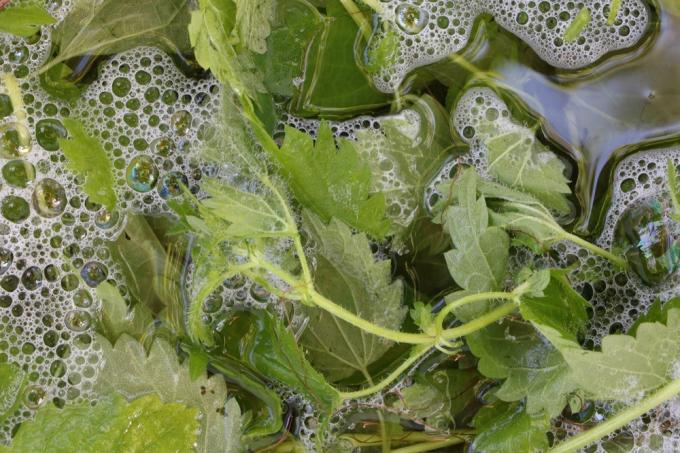
table of contents
- The red beetle
- Eating behavior
- Lily beetle and its larvae
- Fight
- Collection and collection
- Fight larvae
- Home remedies
- Predators
For many hobby gardeners, lilies are an essential part of the garden, because their majestic flowers are a real eye-catcher. In addition, they belong to those plants that are actually very robust against diseases and pests. Yes, actually, if it weren't for the lily chicken that puts an abrupt end to the splendor. But don't worry, you can also fight the lily chicken successfully.
The red beetle
The lily chicken, also known as the lily beetle, is a beetle six to eight millimeters in size. Its scientific name is Lilioceris lilii. Due to its bright red body color and the black head and legs, it stands out on the green leaves of the lilies.
Eating behavior
Lilioceris lilii taste all parts of the plants. He only spares the underground parts. And if it is not fought, it can even eat the plant. The damage caused by the beetle is particularly great if it nestles at the beginning of budding. Therefore it can happen that the little nuisance appears as early as April. As the name suggests, the red beetle prefers to eat lilies, and here it is particularly fond of the hybrid species. But there are also chives, garlic and vegetable onions on his menu.
Lily beetle and its larvae
In the case of the lily chicken, not only the adult beetles are a danger to plants, but also its yellow-brown, slimy larvae. Since the larva is even more voracious than the adult lily beetles, it does even more damage, because a larva eats its way through the plant for four weeks.
Tricks of the lily beetle and larvae
Lilioceris lilii uses various tricks to escape from its enemies. The larvae carry their droppings on their backs so that they are spared from predators. When disturbed, the lily beetles simply drop on the ground, but in such a way that they land on their bright red back. And so the search for a black beetle on black earth is usually not crowned with great success.
Fight
Even if the red lily chicken is a real nuisance, you shouldn't fight it with the chemical club, as there are some effective alternatives.
Collection and collection
Even if it disgusts some people, Picking up the lily beetle is still the safest way to get rid of the pest. It is important that you also take the voracious larvae and eggs of the beetle with you when you collect them. For the lily beetle, gathering is a disturbance in its day. And he uses the fall-to-the-ground trick. Since this trick cannot be avoided, you should take advantage of it:
- put a container under the plant
- put a light-colored fleece under the plant
The lily beetle's dark belly is of no use as a camouflage and you can easily collect the pests.
tip: You can also intentionally disturb the lily beetles so that they can drop.
The best time to collect the pest is in the early hours of the morning, as it is not so agile then.
Fight larvae
To free the lilies from the larvae, it is best to use a strong jet of water to wash them off the plant.
tip: Up or The larvae then no longer make it back, they are too immobile.
Home remedies
With larger groups of plants, collecting is not only tedious, but also not very effective. Therefore, in this case, you should resort to home remedies that drive away the pest.
Soap-alcohol mixture
A tried and tested home remedy is a mixture of soap, alcohol and water. To do this, mix a teaspoon of soap with 200 milliliters of spirit and one liter of water. The lilies are then sprayed with this mixture. This is how you drive away the lily beetles and kill their larvae.
tip: You can achieve the same effect with a mixture of ethanol, soft soap and water.
Nettle manure
Nettle manure, also called nettle broth, also helps to control the lily beetle, because the pest does not like spraying with nettle manure at all. For the nettle manure, add 250g of dried nettles and one kilogram of fresh nettles with ten liters of water. After that, cover the container and let the mixture stand for at least 24 hours.
When the liquid manure is ready, the lilies are sprayed with it undiluted. To protect the plants, you should spray in the sun. Spraying in the rain is also completely ineffective. In order for the nettle broth to work, the plants must be sprayed several times.

tip: The addition of rock flour should help against the stench.
Tansy broth
The lily chicken also drives away a tansy broth. To make them, boil 100g of dried flowers with three liters of water. After the brew has cooled, it must be strained. After that, you can spray the plants with the broth. As with nettle manure, you should also pay attention to the weather conditions and repeat the treatment several times.
Neem or Neem oil
Spraying neem oil does not help against the adult lily beetles, but against the voracious ones larva of the beetle. Because the neem oil disturbs the hormone balance of the larva, so it can no longer pupate.
Coffee grounds
Place coffee grounds under the plants to drive away the lily chickens. They don't like that at all.

Algae lime and rock flour
Dusting the plants with algae lime and rock flour also helps against the lily chicken. It is important that the dust also gets to the underside of the leaf. To make it easier for him to get there, build a powder puff out of a piece of fine tights. Then gently hit the underside of the sheet of paper with it.
Note: Which of the mentioned home remedies works best against Lilioceris lilii cannot be said in advance. Therefore, you should try different means.
Predators
You will also get support from nature in combating the pest, because the red lily beetle has not as few predators as you might think. So team up with birds, hedgehogs, shrews or the predatory beetle by offering them a species-appropriate environment.





